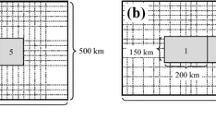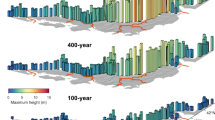Abstract
In this study, the effect of delayed multi-fault rupture on maximum tsunami runup was investigated. Rupture of faults mostly occurs in a delayed pattern; however, conventional models assume that rupture of faults occurs simultaneously. We simulated the effect of delayed rupture of faults on the maximum tsunami runup on the east coast of Korea with reference to the 1993 Hokkaido earthquake. The Cornell Multi-grid Coupled Tsunami Model (COMCOT) was used to generate the maximum tsunami runup database on the east coast of Korea. The delay time between faults was examined with a 1-min interval up to 10 min. The maximum tsunami runup showed a tendency to increase significantly in a specific space and time interval. The middle part of the east coast of Korea (from Gangneung to Samcheok) showed a significant increase in the maximum tsunami runup. In particular, the maximum tsunami runup due to delayed rupture can be larger than that of simultaneous rupture of faults by up to a factor of 1.8. To quantitatively evaluate the effect of delayed rupture, we performed a data-driven analysis using Bayesian network with the database generated from numerical tsunami modeling. It was found that the maximum tsunami runup is amplified at a specific delay time (e.g., 4 min and 9 min) between rupture of faults and this is closely related to the superposition of tsunami component generated by each fault. Our results demonstrate that the effect of delayed rupture should be considered in the prediction of tsunami runup.
Similar content being viewed by others
References
Ammon CJ, Ji C, Thio HK, Robinson D, Ni S, Hjorleifsdottir V, Ichinose G (2005) Rupture process of the 2004 Sumatra-Andaman earthquake. Science 308:1133–1139, DOI: https://doi.org/10.1126/science.1112260
Antuono M, Brocchini M (2007) The boundary value problem for the nonlinear shallow water equations. Studies in Applied Mathematics 119(1):73–93
Antuono M, Brocchini M (2010) Analysis of the nonlinear shallow water equations over non-planar topography. Studies in Applied Mathematics 124(1):85–103
Burbidge D, Mueller C, Power W (2015) The effect of uncertainty in earthquake fault parameters on the maximum wave height from a tsunami propagation model. Natural Hazards and Earth System Sciences 15:2299–2312, DOI: https://doi.org/10.5194/nhess-15-2299-2015
Choi BH, Pelinovsky E, Hong SJ, Woo SB (2003) Computation of tsunamis in the East (Japan) Sea using dynamically interfaced nested model. Pure and Applied Geophysics 160:1383–1414, DOI: https://doi.org/10.1007/s00024-003-2352-x
Fuentes M, Riquelme S, Ruiz J, Campos J (2018) Implications on 1+1 D tsunami runup modeling due to time features of the earthquake source. Pure and Applied Geophysics 175(4):1393–1404, DOI: https://doi.org/10.1007/s00024-018-1804-2
Fujii Y, Satake K (2007) Tsunami source of the 2004 Sumatra-Andaman earthquake Inferred from tide gauge and satellite data. Seismological Society of America 97:192–207, DOI: https://doi.org/10.1785/0120050613
Hammack JL (1973) A note on tsunamis: Their generation and propagation in an ocean of uniform depth. Journal of Fluid Mechanics 60:769–799, DOI: https://doi.org/10.1017/S0022112073000479
Imai K, Satake K, Furumura T (2010) Amplification of tsunami heights by delayed rupture of great earthquake along the Nankai trough. Earth, Planets and Space 62:427–432, DOI: https://doi.org/10.5047/eps.2009.12.005
Ishii M, Shearer PM, Houston H, Vidale JE (2005) Extent, duration and speed of the 2004 Sumatra-Andaman earthquake imaged by the Hi-Net array. Nature 435:933–936, DOI: https://doi.org/10.1038/nature03675
Jho MH, Kim GH, Yoon SB (2019) Construction of logic trees and hazard curves for probabilistic tsunami hazard analysis. Journal of Korean Society of Coastal and Ocean Engineers 31:62–72, DOI: https://doi.org/10.9765/KSCOE.2019.31.2.62 (in Korean)
Jung TH, Son S (2018) Propagation of tsunamis generated by seabed motion with time-history and spatial-distribution: An Analytical Approach. Journal of Korean Society of Coastal and Ocean Engineers 30:263–269, DOI: https://doi.org/10.9765/KSCOE.2018.30.6.263 (in Korean)
Jung T, Son S (2020) The effect of fault failure with time difference on the runup height of east coast of Korea. Journal of Korean Society of Coastal and Ocean Engineers 32:223–229, DOI: https://doi.org/10.9765/KSCOE.2020.32.4.223 (in Korean)
Kim HS, Kim HS, Kang YS (2008) The investigation of tsunami occurrence and warning system. Journal of the Korean Society for Marine Environment & Energy 6:215–220 (in Korean)
Le Gal M, Violeau D, Ata R, Wang X (2018) Shallow water numerical models for the 1947 gisborne and 2011 Tohoku-Oki tsunamis with kinematic seismic generation. Coastal Engineering 139:1–15, DOI: https://doi.org/10.1016/j.coastaleng.2018.04.022
Lee E, Jung T, Shin S (2020) Numerical and probabilistic study on the optimal region for tsunami detection instrument deployment in the eastern sea of Korea. Applied Sciences 10:6071, DOI: https://doi.org/10.3390/app10176071
Madsen PA, Fuhrman DR, Schaffer HA (2008) On the solitary wave paradigm for tsunamis. Journal of Geophysical Research-Oceans 113(C12), DOI: https://doi.org/10.1029/2008JC004932
Maercklin N, Festa G, Colombelli S, Zollo A (2012) Twin ruptures grew to build up the giant 2011 Tohoku, Japan, earthquake. Scientific Reports 2:1–7, DOI: https://doi.org/10.1038/srep00709
Norsys (2020) Netica application. Norsys Software Corp., Retrieved December 14, 2020, https://www.norsys.com/netica.html
Park SC, Lee JW (2014) Fundamental research for improvement of tsunami warning system of KMA. Journal of the Earthquake Enginerring Society of Korea 86–86 (in Korean)
Ren Z, Liu H, Zhao X, Wang B, An C (2019) Effect of kinematic fault rupture process on tsunami propagation. Ocean Engineering 181:43–58, DOI: https://doi.org/10.1016/j.oceaneng.2019.03.045
Rhie J, Dreger D, Burgmann R, Romanowicz B (2007) Slip of the 2004 Sumatra-Andaman earthquake from joint inversion of long-period global seismic waveforms and GPS static offsets. Seismological Society of America 97:115–127, DOI: https://doi.org/10.1785/0120050620
Riquelme S, Schwarze H, Fuentes M, Campos J (2020) Near-field effects of earthquake rupture velocity into tsunami runup heights. Journal of Geophysical Research: Solid Earth 125:e2019JB018946, DOI: https://doi.org/10.1029/2019JB018946
Satake K, Fujii Y, Harada T, Namegaya Y (2013) Time and space distribution of coseismic slip of the 2011 Tohoku earthquake as inferred from tsunami waveform data. Bulletin of the Seismological Society of America 103:1473–1492, DOI: https://doi.org/10.1785/0120120122
Sohn DH, Park SC, Lee JW, Moon KS, Kim HS, Lee DK (2018) Classification of tsunami hazard area along the eastern coast of south Korea based on improved tsunami scenario database. Journal of the Korean Society of Hazard Mitigation 18:303–310, DOI: https://doi.org/10.9798/KOSHAM.2018.18.3.303 (in Korean)
Son S, Lynett PJ, Kim DH (2011) Nested and multi-physics modeling of tsunami evolution from generation to inundation. Ocean Modelling 38(1–2):96–113, DOI: https://doi.org/10.1016/j.ocemod.2011.02.007
Wang X (2009) User manual for COMCOT version 1.7. Cornell University, Ithaca, NY, USA, 26
Wilson KE, Adams PN, Hapker CJ, Lentz EE, Brenner O (2015) Application of bayesian networks to hindcast barrier island morphodynamics. Coastal Engineering 102:30–43, DOI: https://doi.org/10.1016/j.coastaleng.2015.04.006
Yang GS (2007) Evaluation of effect on the sea water level of eastern coast by tsunami originated at the sea near Japan. MSc Thesis, Korea Maritime University, Busan, Korea (in Korean)
Acknowledgments
This research was supported by the SeeAt Program funded by the Korea Meteorological Administration, South Korea (KMI2018-09510).
Author information
Authors and Affiliations
Corresponding author
Rights and permissions
About this article
Cite this article
Yeo, I., Jung, TH., Son, S. et al. Probabilistic Assessment of Delayed Multi-fault Rupture Effect on Maximum Tsunami Runup along the East Coast of Korea. KSCE J Civ Eng 26, 1–12 (2022). https://doi.org/10.1007/s12205-021-0272-x
Received:
Revised:
Accepted:
Published:
Issue Date:
DOI: https://doi.org/10.1007/s12205-021-0272-x




